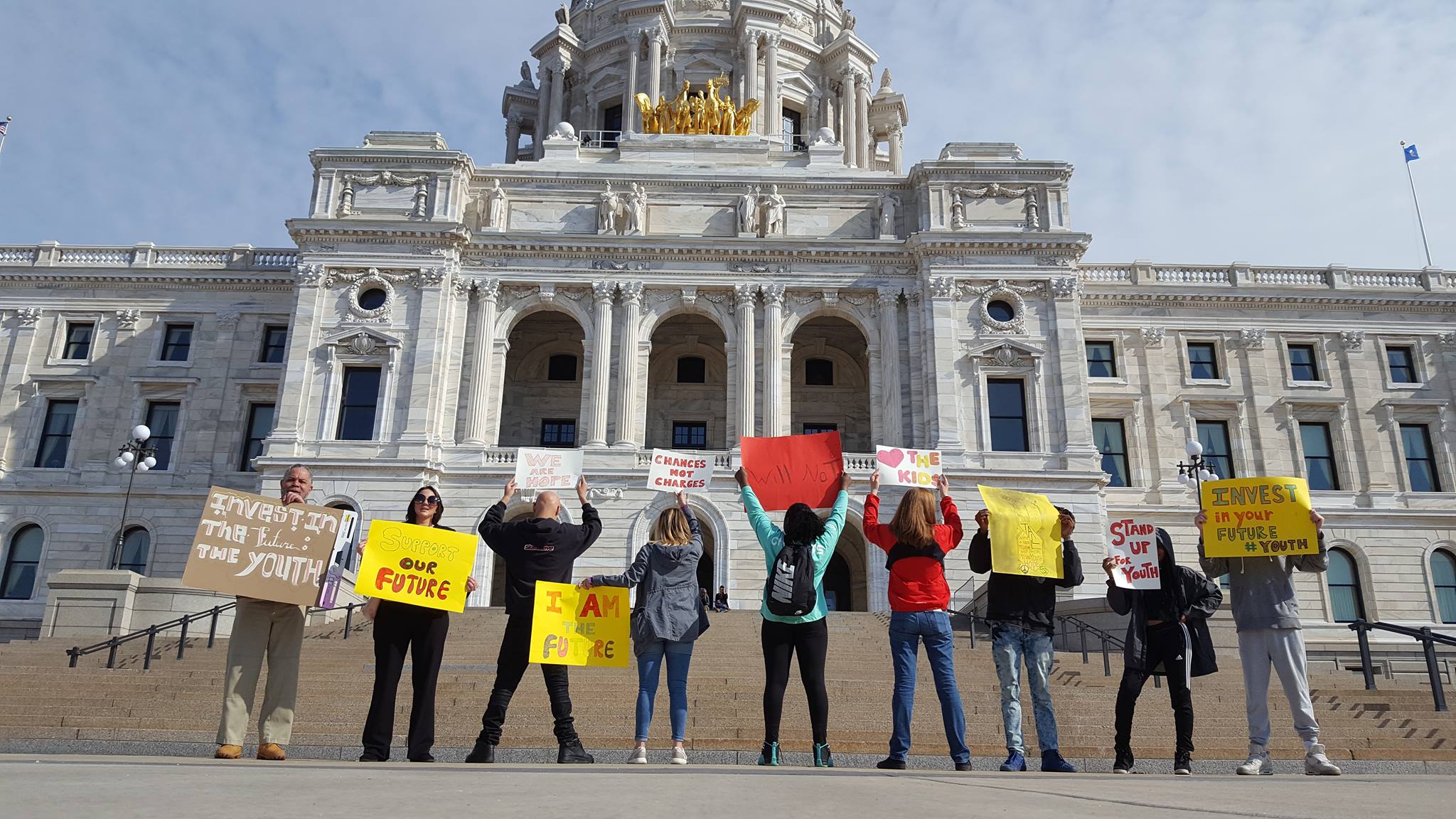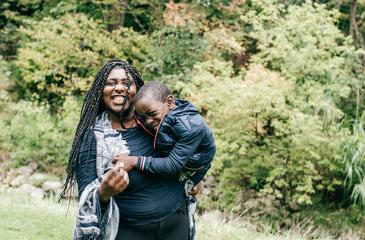A youth shelter and University of Minnesota researchers teamed up to address the unmet needs of pregnant or parenting teens who are also facing homelessness. This vulnerable group often slips through the cracks of social services, finding themselves both ineligible for shelter and with few healthcare resources to meet their unique needs.
Janna Gewirtz O'Brien, MD, MPH, an Assistant Professor at the University of Minnesota, noticed this while working at The Bridge for Youth in Minneapolis as an Adolescent Medicine Fellow and through her work as a physician:
“I saw many young people facing this really difficult situation: Once they became pregnant or if they’re a parent, there were essentially no beds in the state. They went from having a place where they could find emergency shelter and housing to where it was almost impossible to find a place to lay their head at night.”
Filling the gap
Christina Woodlee, MPA, then Program Director of The Bridge for Youth shelter, repeatedly saw that same problem first-hand, and joined forces with Dr. Gewirtz O'Brien to pursue a solution.
They applied for — and received — a Community Health Collaborative Pilot grant along with Dr. Gewirtz O'Brien’s mentor on the project, Chris Mehus, PhD. The grant supports collaborative projects that improve health equity in Minnesota and is offered through CTSI’s Community Engagement to Advance Research and Community Health (CEARCH) team.
The team’s funded project was one aspect of an ambitious plan to open Minneapolis-based Marlene’s Place, which would soon be Hennepin County’s first transitional housing and case management program for pregnant or parenting youth and their children. In addition to being a place to stay, Marlene’s Place would provide healthcare and other services — all on-site.

For their CTSI-funded project, Woodlee and Drs. Gewirtz O'Brien and Mehus sought to develop and evaluate an evidence-informed health empowerment program that could be used in Marlene’s Place. Developed in partnership with youth and staff at The Bridge for Youth, the program includes three components:
- Strengths-based, trauma-informed on-site healthcare for youth and their children
- A youth-driven health empowerment group covering a range of health topics related to adolescent and child health
- Training and support for agency staff regarding health
Driven by youth and agency staff, the program aimed to uplift and empower youth to have the information, resources and support they needed for themselves and their children to be healthy and thrive.
Funding would add research rigor to their plans, helping them make sure the shelter’s health programming was feasible, community-driven, could truly help young parents and parents-to-be, and could ultimately be adopted by similar organizations. And now, with grant funds in hand, they had a boost to do just that.
Community voices
The team quickly got to work, completing much of their research in the first four months of receiving the grant. Some of the project’s most valuable insights stemmed from the focus groups.
“Focus groups helped us better understand the experiences and needs of young people and shelter staff,” said Dr. Gewirtz O’Brien. “Listening to their voices and adapting our approach was a big part of what would make our health programming successful.”
Input sometimes went against what they originally had in mind. For example, the team initially envisioned that health education would focus on sexual reproductive health and healthy relationships, but feedback from youth and staff during implementation led them to pivot to a more strengths-based, multi-generational approach that covered a broader spectrum of topics. Now the shelter covers health and wellbeing more generally, tackling topics such as mental health, nutrition, physical activity, early childhood development, and prenatal care.
To youth and staff, it was important that the shelter’s health programming: Be adaptable; incorporate a strengths-based, culturally-competent, and trauma-informed approach; develop skills around both health and healthcare; leverage the key role of staff in promoting youth health; and integrate youth voice.
Funds also enabled the team to train staff as well as hire a consultant from the University’s Prevention Research Center to align their health programming with evidence-based practices.

Making an impact
In 2019, The Bridge for Youth opened their shelter’s newest wing — called Marlene’s Place — and welcomed five single moms between the ages of 16 and 20 along with their children. The newly adapted health empowerment programming blends on-site healthcare with health education is central to their experience.
"At our shelter, we’re empowering young parents and parents-to-be to lead healthier lives, even though they face the enormous challenge of experiencing homelessness," said Woodlee. "This wouldn’t have been possible had it not been for the funding we received."

The team found that youth who graduate from the shelter’s health education program stay connected through healthcare for themselves and their family. This is critical to combating the cycle of intergenerational homelessness.
“For little ones, that's a big deal,” said Woodlee.
Scaling up
The documented success of both the health empowerment program and Marlene’s Place as a whole positioned The Bridge for Youth to secure additional, federal funding.
“CTSI funding enabled us to start gathering some of the qualitative and quantitative data and show the long-term impacts it could make if scaled up even higher,” said Woodlee.
During the first few months of the COVID-19 pandemic, The Bridge for Youth opened a second shelter, called Gloria’s Place. It’s the only emergency shelter in Minnesota specifically for unaccompanied, pregnant or parenting youth and their young children (Marlene’s Place provides longer-term transitional housing).
Today, the team is focused on increasing the resources available through both Marlene’s Place and Gloria’s Place, and sharing their results to encourage shelters and other organizations across the country to adapt their programming for their own youth communities.
“We were intentional about how we designed the program, so that it could be scaled and sustainable and replicated across the country, but also have key measures around long-term impact,” said Woodlee. “What is the true impact, on not just the housing situation, but on young people and their families? And what are we doing to fully disrupt the cycle of poverty with healthcare at the core as well?”
Sharing findings
Woodlee and Drs. Gewirtz O’Brien and Mehus have been broadly sharing what they’ve learned. They’ve published their findings in the Progress in Community Health Partnerships, the Journal of Adolescent Health, and have submitted work for further publication.
Plus, they’ve presented at the Council on Community Pediatrics, the American Academy of Pediatrics’ national conference and exhibition, federal runaway and homeless youth conferences, the 2020 Minnesota Department of Health Eliminating Health Disparities Initiative Conference, and are scheduled to present at the 2022 Minnesota Coalition for the Homeless Annual Conference later this year.
Now, the team is striving to spark a change in policy. So far, they’ve presented or testified at the Minneapolis City Council, Hennepin County Board of Commissioners, and the Minnesota House and Senate.
A change in narrative
As the team shared their findings, they’ve seen what’s perhaps an even more significant outcome: A shift in narrative at the policy level about pregnant and parenting youth experiencing homelessness. Woodlee — who today is The Senior Director of Strategy & Partnership at The Bridge for Youth — recalls facing naysayers when they began pursuing their vision for Marlene’s Place and its health empowerment program:
“Some doubted the concept of Marlene’s Place, saying it would enable the problem by giving youth a place to go when they're not making responsible choices. And we learned that wasn’t true — that's judgment, that's bias, that's not the reality.”
Through data and stories from youth participating in the shelter’s health empowerment programming, the team demonstrated the success and potential of a strengths-based, integrated approach centered on youth voices. Rather than prescribing solutions without youth input, they’re giving them autonomy over their and their children’s lives and health. And it’s been working.

The team continues to applaud the youth at the heart of their work, crediting them with the success and potential of the shelter’s health programming.
“I'm really proud of what we’ve done: We’ve created a youth-driven, multifaceted health program that's meeting the needs of young people and their families,” said Dr. Gewirtz O'Brien. “The young people who were there — especially at the time of the program’s inception — really helped to create it and make it what it has become. They’re some of my favorite people I've ever worked with and are remarkably resilient and savvy.”
This research was supported by the National Institutes of Health’s National Center for Advancing Translational Sciences, grant UL1TR002494. The content is solely the responsibility of the authors and does not necessarily represent the official views of the National Institutes of Health’s National Center for Advancing Translational Sciences.
